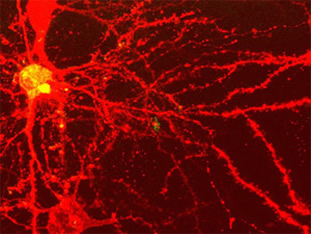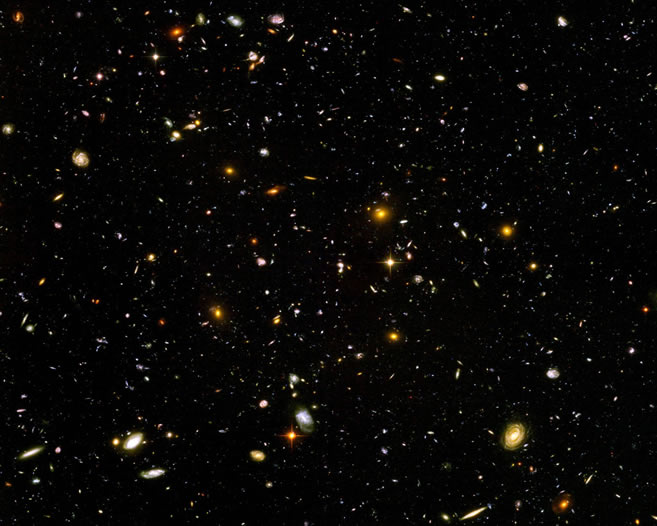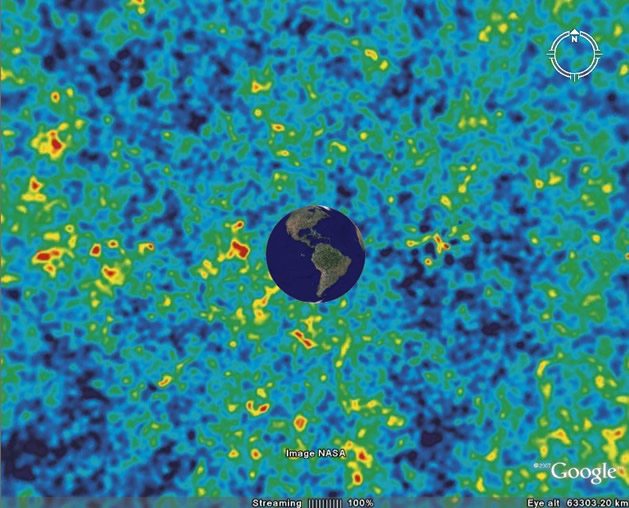

 |
 |
 |
 |
 |
 |
 |
If we were to zoom way out past our own galaxy, we would see that the Milky Way and the other galaxies in the Local Group are part of an enormous supercluster of galaxies that stretches for billions of light years across the Universe. This supercluster connects and intertwines with other superclusters, creating a sort of galactic network. Below is an computer model of what the Universe probably looks like as depicted by the millennium simulation:

This image bears a striking resemblance to something else we might be familiar with:

The above image is of a neuron in the human brain. The resemblance between these two objects, one very small and one staggeringly huge, is really very incredible. Even now astronomers are looking backwars in time and coming ever closer to the event that is theorized as the beginning of the Universe: The Big Bang. The Big Bang theory speculates that between 13 and 14 billion years ago, all the matter and energy in the Universe was condensed into a single incredibly dense and hot point. At some point in time, this point erupted in an unbelievably huge explosion that blasted out subatomic particles in every direction. It is estimated that temperatures were so high, the subatomic particles in existence were bouncing around at relativistic speeds, with particle-antiparticle pairs constantly being created and destroyed. Then at some point the Universe began to expand and cool, and just a few minutes into its existence, the first atomic nuclei began to form. It would take another 377,000 years before electrons joined with these nuclei to form the first hydrogen and helium atoms. The Universe then entered what astronomers call the "Dark Ages." During this time the Universe was foggy and opaque, and what little light there was would not have been visible through any telescope. Following the Dark Ages was a time when atoms began to be drawn together, and the first stars formed. These early stars eventually drew together to form the very first galaxies and quasars, which are incredibly old and distant galaxies with very bright and active cores. Quasars are among the brightest objects in the sky. In 2007, Richard Ellis at the California Institute of Technology and his team discovered six star-forming galaxies situated some 13.2 billion light years away. According to the Big Bang theory, these galaxies were forming when the Univeres was just 500 million years old, and by viewing them now, we are seeing the Universe as it was at that age.
The Hubble Ultra Deep Field, or Hubble UDF, is an image that was taken by the Hubble Space Telescope in 2004. Astronomers aimed the telescope at a patch of sky in the constellation Fornax that is roughtly a 10th the size of the full moon. As viewed from any other telescope, this patch of sky appeared completely empty. Hubble opened its lens and took two exposures, one from September to October of 2003 and one from December of 2003 until January of 2004. This is the image that Astronomers recieved:

Every single point of light in the above image is an entire galaxy. It is the deepest image ever taken of the Universe and shows galaxies that were forming between 800 and 400 million years after the Big Bang. The large yellow galaxy in the lower right contains roughly eight times as many stars as the Milky Way, and is so large that according to current laws of physics it should not exist, suggesting that the laws of energy and matter may have been different in a younger Universe.
When viewed with a normal light telescope, the space between the stars appears black and empty. But when viewed through a radio telescope, the Universe looks something like this:

This is a simulation in Google Earth showing the Cosmic Microwave Backgrund. The CMB is basically leftover radation from the Big Bang. When the Universe was young it was also smaller and hotter, and filled with a sort of hydrogen plasma. When it finally cooled off enough for stable atoms to form, they could no longer absorb the thermal radiation of the plasma, and the Universe became transparent. The leftover photons from this time have been bouncing around the Universe ever since, though they are growing fainter over time since the Universe is expanding and the exact same number of photons are having to fill a larger and larger space. Radiation from the CMB can even be observed on Earth without any special equipment. If you turn your television set to a channel that has no signal, part of the white noise you see is radiation from the CMB. You can get the Big Bang right on your TV!
Asronomers are as yet unsure whether or not this universe will continue to expand forever, or if it will at some point stop, though they do know that it is expanding due to an observable red shift. Light travels in waves, and on the light spectrum light with a longer wavelength appears redder. This means that infrared light will have a longer wavelength than ultraviolet light. When a light-emitting object like a star moves away from us, it creates a sort of Doppler Effect in the light spectrum, stretching out the light waves and making them appear redder. In an open universe model, our universe would continue to expand forever at an exponentially fast rate. If this happens, astronomers believe that the Universe will end up expanding at a speed that is faster than light. When this happens everything else in the Universe will become invisible to us, though by the time this happens Earth will probably no longer exist. In a closed universe model, the Universe would expand out to a finite point, stop, and begin to contract in on itself again. At some point, the Universe would eventually collapse into a single point, similar to its existence before the Big Bang, in a theoretical event known as the Big Crunch.
That concludes our short tour of the Universe! I hope you found it informative and enjoyable. Feel free to contact me over at the Wormhole Mail page. Keep on exploring!